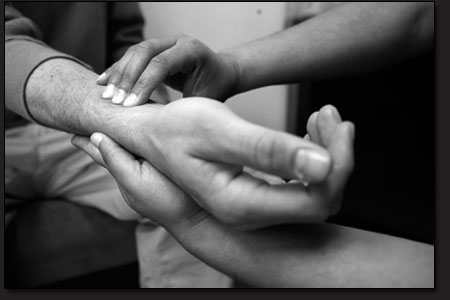|
| ||||
| The science of life
by Shawna Bethell Walk into Amita Nathwani’s office and you find yourself surrounded by warm, rich, earth tones, comfortable chairs and bright silk pillows. It’s immediately comforting, as is Nathwani herself who will sit opposite you in one of those chairs, look at you with her gentle demeanor and ask, “So, how’s your body doing?” As a practitioner of Ayurvedic medicine, a 5,000-year-old holistic healing system from India, Nathwani is first and foremost interested in having a conversation with her patients about their bodies, their temperament, their daily lifestyle “No one is the same,” explains Nathwani who established the Ayurveda Center of Durango. “Ayurveda is a whole system of healing at all levels, from our minds to the specifics of our individual bodies. It really is the science of life.” In layman’s terms, Ayurveda focuses a great deal on who we are as individuals, our body types, the foods we eat, how we process that food and how we interact with our environment. According to Nathwani it is about what we bring into our bodies and how that food, which has specific properties of its own, can either sustain us or harm us depending on how well it is digested. In the terms of translated Sanskrit, it is about a abalanced dosha (of which there are three: vata, pitta and kapha), balanced digestion, happiness of mind, gratitude of the senses, and a connection to something greater. The doshas, based on a person’s body type and constitution, are the beginning point of a diagnosis. For example, someone who is vata (air) who becomes imbalanced might exhibit symptoms such as bloating in their digestive tract (a physical symptom) or high anxiety (a mental symptom), and thus should eat more grounding foods such as whole grains and steamed vegtables. Likewise, someone who is predominately pitta (fire) whose dosha becomes imbalanced, should eat cooling foods as opposed to spicy foods which would increase the heat in the body’s digestive system. If it all begins sounding rather complicated, stop for a moment, because the practice is actually very natural. We as humans are part of the environment in which we live. As such, we should eat food that is grown and naturally accessible in that environment and behave in ways that sustain a sense of balance around us. “The reason I love Ayurveda is because it is so holistic,” explains clinical herbalist Deb Swanson of Dancing Willow Herbs. “We here in the Southwest tend toward a constitutional type that is hot, dry, high and windy. The herbs that grow here treat ailments that arise here. Everything we need can be found in our own environment.”
Nathwani often works with Swanson, as well as Joslyn Stancampiano, of Hummingbird Herbals, to find treatments that will support and sustain her patients. “It’s just so practical,” says Swanson. “Ayurveda is as much about a way of living as it is a treatment.” Nathwani would agree. “It is about getting rid of the root cause of the illness as well as treating the ailment itself.” As a young girl, Amita Nathwani had always been interested in healing. Her father was a physician of Western medicine but had always been interested in alternative practices. Once, after returning from a three-week class on alternative health care, her father told Nathwani that during those weeks he’d caught a glimpse of something he’d never seen before. From then on, he encouraged his daughter to follow that healing path. “I remember on the last day of classes,” says Nathwani of her medical training, “The old healer came into our classroom and told us to forget everything we’d learned, not to go on what we knew, but instead go to our patients and listen. He said to be there for that person and help them figure out what to do next.” Dr. Megan Lewis, a family practitioner of the Western tradition who works with Nathwani on patient care, said much of Western medicine has lost sight of the importance of that doctor-patient bond. “She doesn’t put people in a box. If people have digestive problems we tend to lump them together with one diagnosis. We aren’t taught anything in medical school about nutrition and diet. Amita will individualize what that person needs.” Lewis considers herself a bridge for people who wouldn’t typically consider a healing practice such as Ayurveda. “Amita was the first alternative practitioner who ever contacted me about one of her patients,” says Lewis. “She judiciously decided this person needed to see a Western medical doctor. Likewise, I send people to Amita who I see as the ultimate dietician.” She added that one day, she hopes to be part of a clinic that includes all types of healing practices. In her mind, being open minded and working cooperatively is the best way to alleviate patient suffering. In addition to the physical, Ayurveda also focuses on mental and spiritual well-being. To that end, Nathwani refers her patients to various yoga classes in the community, as yoga is one of the branches of Ayurveda. As she explains it, it is our minds asking our bodies to move in a certain way and breathe in a certain way that brings balance of mind and spirit as well as physical strength and control. It is that balance that each of these practitioners strives to meet, whether working alone or together, bridging cultural chasms to find the best way to alleviate a patient’s pain. •
|
In this week's issue...
- May 15, 2025
- End of the trail
Despite tariff pause, Colorado bike company can’t hang on through supply chain chaos
- May 8, 2025
- Shared pain
Dismal trend highlights need to cut usage in Upper Basin, too
- April 24, 2025
- A tale of two bills
Nuclear gets all the hype, but optimizing infrastructure will have bigger impact



